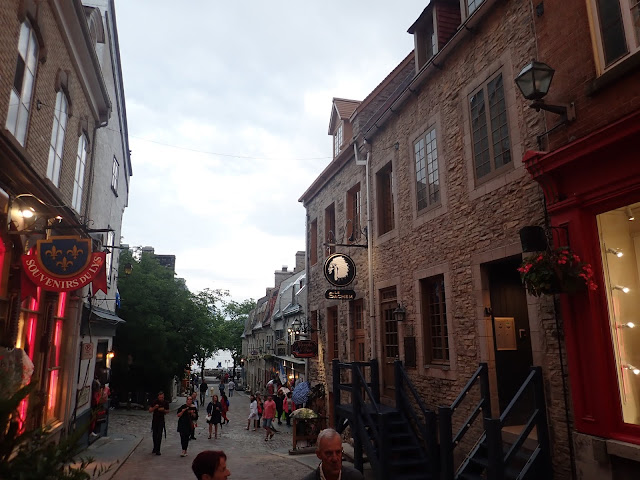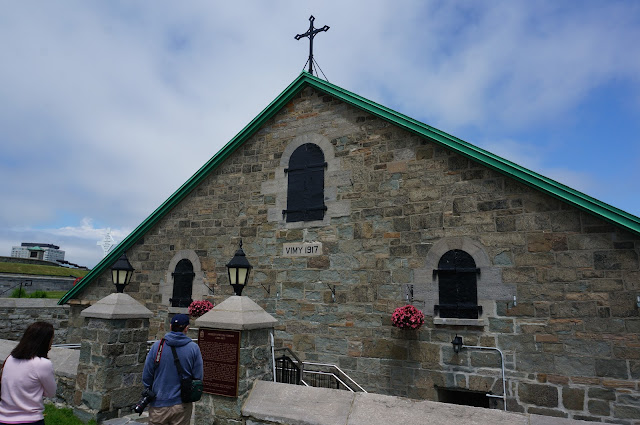Quebec City - Old Europe Just a Few Hours Away
Leaving Toronto, we boarded the VIA Rail train to Quebec City. The train ride took about eight hours, after a brief stop in Montreal, a natural middle point between the two. Montreal could also be seen as a cultural middle point between the older French culture of Quebec and the English culture of Ontario. If you are going to take this trip, and have a few extra dollars burning a hole in your pocket, I would highly recommend the first class seats. If you're going to be on a train for eight hours you may as well as comfortable as possible. The whole train had WiFi service included, and the first class seats came with complimentary alcoholic beverages and full meals, much like a first class flight. When you get to Quebec City, you will arrive at the Gare du Palais. From there you will either walk, which is completely reasonable, or get a taxi into the old walled city of Quebec. It's completely possible to get to Quebec City without ever leaving the ground. Amtrak runs daily trains from New York City to Montreal, and you can then transfer to the Quebec line.
Settled in 1608, one year after the establishment of the Jamestown Colony in Virginia, explorer Samuel de Champlain and his crew founded this settlement on the banks of the St. Lawrence River. The word Quebec is actually Algonquian for "where the river narrows." The French actually tried to settle the land in 1541, but abandoned the venture after only a year. Most European settlements of the 17th Century often took on a utilitarian feel, using what they had to survive. The people of Quebec, however, over several centuries, built a classical walled city that rivals any in Europe. Inside the only walled city in the United States or Canada, you will find cobblestone streets, centuries old buildings with ceiling heights that make a tall man like me a little uncomfortable, monuments to long gone explorers, and streets so narrow you want to see if you can reach across and touch the buildings on both sides. Probably the most iconic site in this medieval city though is not from that time period. Le Château Frontenac is a mindbogglingly large 19th Century hotel built during the time of railroad tycoons to give people a place to stay when they visited Quebec City. The 18 story tall compound hovers at the top of the old town like a modern day lord's castle. Next to the Fronternac is the city's famous boardwalk. On this boardwalk you will find countless street performers, food vendors, and unblocked views of the river and surrounding town. While we were in town we participated in a unique experience for travelers from the United States, Canada Day. On the boardwalk, we stood just a few feet from the stage while local leaders praised the people of Canada in both French and English. The keynote speaker, Jean-Yves Duclos, a Canadian national minister, welcomed visitors from around the world to Quebec, and even welcomed Americans as Canada's "family from the south." Standing proudly at attention was the Royal 22nd Regiment, Canada's only French speaking military unit, and their mascot, Batisse the Goat. This goat literally stood silent and didn't move for an hour while the speakers were talking. The highlight of Canada Day was the free cake the Fronternac fed to thousands of spectators as part of the celebration. The low point of the day was the labor strike of government employees who literally stood in the crowd blowing horns and whistles while the speakers praised their nation.
If you are visiting Quebec City, you have a decision to make about where you want to stay. The city itself is quite hilly, and you need to be ready to climb steps or steep hills frequently during the stay. We stayed at the high point of the city, but we kept finding ourselves drawn down to the charming Quartier Petit Champlain at the bottom of the city heights. This shopping district is made up of buildings from the 18th and 19th Centuries, but the iconic staircase, questionably named the Breakneck Steps, were built in 1635. At the bottom of the steps are clothing shops, local artisans, restaurants, ice cream shops, and just about anything else a visitor could be looking for. While you are walking around the city look for the murals that are on the sides of many walls. The Fresque des Petit Champlain is a four story tall mural that depicts the city in the mid-18th Century. Keep walking and find the Fresque des Quebecois, a five story tall mural of the history of the city and the important leaders who have come from Quebec over the centuries. From the Petit Champlain you can walk down to the old port, and stroll along the water. If you want a quieter street to drink a coffee or go antique shopping wander down to Rue Saint-Paul, in between Petit Champlain and the port.
Quebec City has a tremendous amount of American history to be located in Canada. Just outside the old town is a park known as the Plains of Abraham. This park, in 1759, was the site of one of the most meaningful battles in North American history. It was here, during the French and Indian Wars that British forces overwhelmed French forces and captured control of the French territory of Quebec. After a decisive loss in a war far too few people in North America know about, the city would again be a scene of battle in 1775, when American forces invaded Canada during the Revolutionary War. The Americans believed the Canadians, especially the French speaking ones, would rally to defeat their British rulers, but that did not happen. On December 31st, 1775, the Battle of Quebec began when American forces invaded following their capture of Montreal. The battle is most famous for the wounding of Benedict Arnold that left him with a permanent limp, and the death of the American general Richard Montgomery. I tell you that to lead into the next must visit spot in Quebec, La Citadelle. An active military base for the 22nd Regiment, this location has been the site of a fort overlooking the city since the 17th Century. The current fort took shape in the 19th Century, when our Canadian neighbors believed the Union Army would wheel north and take over Canada following four years of fighting in the Civil War. The fort was the location of the Quebec Conferences of World War II that saw Winston Churchill and Franklin Roosevelt meet to discuss the war. The tour there is well worth at least a half a day. Each person is given a guided group tour, in French or English, which takes about an hour. Inside of the fort is arguably the oldest active military building in all of North America. While you are there, don't leave after your tour of the base. Not only is this a military base, and yes the soldiers will yell at you if you wander off from your tour, but it's also home to the Governor General of Canada. Canada does something that is hard for Americans to understand, they divide their leadership position into two people, the Prime Minister and the Governor General. While the Prime Minister has a majority of the power, the Governor General is appointed by the Queen of England, and has supreme authority to overrule any decision from the Canadian Parliament. Mostly a figurehead position now, the position has been held by some impressive figures. Every person can tour her home, some of it, included with your admission. This massive complex is more than 150 rooms, and could also double as a Canadian art museum.
There is so much more I could talk about, but I have been going on for far too long. While you are in town go eat at Aux Anciens Canadiens, located in a former home built in 1675. Walk across the street and look at the tree that has a cannon ball logged in its trunk that's been there since the French and Indian War. Wander out from the old town and walk along the walls of the fortified city. As you are walking around, look for the history plaques mounted on the walls around the city. The city is also beautiful outside of the walls. You can go on a tour of the provincial capital of Quebec, and then keep moving to Avenue Cartier, which was lined with more restaurants than you could eat at in a month. While we were there we walked down to Battlefields Park, just beside the Plains of Abraham, where the city was hosting a local festival with face painting and animal rides for children. The point is there is more than anyone could have done in four days, and what seems like a lifetime supply of sites to be seen. I know I say this often, but I genuinely can't wait to visit Quebec City again. Everyone we met was so friendly, the town was so beautiful, and the history was so overwhelming that I didn't want to leave. I hope that any of you who have never heard of Quebec City, or have but have not considered visiting there, will give it a chance, it's a gem that has been hidden for too long.































Post a Comment